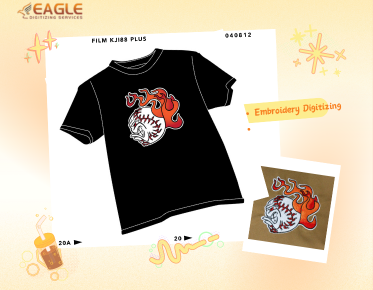Working with Challenging Fabrics: Expert Embroidery Solutions
Embroidery, an art both
delicate and bold, offers boundless avenues for creativity. But when faced with
challenging fabrics, even the most seasoned embroiderer may feel their pulse
quicken. Yet, it’s precisely in these moments of grappling with tricky
materials that true artistry emerges. There’s a certain satisfaction in
mastering the temperamental nature of fabrics that refuse to cooperate at first
touch, making the final stitch all the more rewarding.
Understanding Challenging Fabrics: What Makes Them Tough?
The
Key Factors That Make Some Fabrics Tricky to Work With
Certain fabrics
present more obstacles due to their structure and behavior. Stretchy materials
can warp and distort, while sheer fabrics risk tearing with the wrong needle or
stitch. The density and weave play a huge role; tight weaves can be stubborn
under the needle, while loose ones might shift unexpectedly.
How
Fabric Weight, Texture, and Stretch Impact Your Embroidery
Fabric weight
determines how much force is needed to pierce the material. Heavier textiles
like denim and canvas may resist the needle, while light fabrics such as tulle
can’t handle much tension. Stretch and texture also affect your stitching;
knits, for example, may spring back, while a plush velvet surface can swallow
your design if not handled with care.
Why
Some Fabrics Are More Prone to Issues Like Puckering or Slippage
Puckering and
slippage happen when the fabric isn’t properly stabilized or tension isn’t
even. Thin, slippery materials like silk or synthetics are infamous for these
issues. A misstep here can turn neat, precise work into a bunched-up mess,
making it essential to know how to anticipate and prevent these problems.
Stretchy Fabrics: Mastering the Art of Embroidery on Stretch Materials
What
Makes Stretch Fabrics Difficult to Embroider?
Stretch fabrics,
like jersey or spandex, are notorious for shifting and warping under the
needle. Their elasticity means they don’t hold shape easily, causing designs to
skew and distort if not properly anchored.
Tips
for Stabilizing Stretch Fabrics Without Ruining the Design
Stabilizers are
your best friends when working with stretch fabrics. Use an iron-on stabilizer
to keep the fabric taut, and consider pairing it with a tear-away or wash-away
stabilizer for additional support. Always test on a small sample before
starting your actual project to ensure everything stays smooth and steady.
Needle
and Thread Choices for Successful Stitching on Stretch Materials
A ballpoint
needle is essential for stretchy fabrics as it slides between the fibers
without breaking them. Opt for a polyester thread—it’s strong, has some give,
and won’t snap easily when the fabric stretches.
Silk and Satin: Luxurious but Difficult Fabrics
Why
Silk and Satin Are Challenging for Embroiderers
Silk and satin
boast unmatched elegance but come with a slippery, delicate nature that’s hard
to control. Their shiny surfaces show every needle mark, and fraying edges can
unravel your patience as quickly as your stitches.
How
to Prevent Snags and Fraying When Working with Delicate Fabrics
Handle silk and
satin with care by using sharp, fine needles and high-quality thread. Prepping
the fabric with a stabilizer is a must. A fusible lightweight stabilizer works
well, as it adheres to the back and minimizes movement without adding bulk.
The
Best Needles, Threads, and Stabilizers for Silk and Satin
A microtex or
sharp needle is ideal for piercing the dense weave without causing visible
holes. Use silk or rayon thread for a seamless finish that complements the
fabric’s sheen. A water-soluble stabilizer can help keep your stitches neat
without leaving a trace once washed away.
Denim and Canvas: Heavy-Duty Fabrics with Serious Potential
How
to Embroider on Thick Fabrics Without Breaking Your Needle
Heavy fabrics
demand a sturdy, sharp needle like a denim or topstitch needle. Avoid cheap or
thin needles that might snap mid-project. Adjust your machine’s speed and
stitch length to handle the added resistance.
The
Importance of Choosing the Right Needle Size and Thread for Denim
For denim and
canvas, opt for a size 90/14 or 100/16 needle paired with a thick, durable
thread like polyester or even embroidery floss. This combination ensures your
stitches are bold enough to stand out while staying secure.
Creative
Techniques for Adding Embroidery to Denim and Canvas
Try contrasting
bright threads with dark denim or use metallics for added pop. Embroidery patches and layered designs add texture and
make a statement. Play with different stitches, from satin to chain, to create
depth and interest.
Leather and Faux Leather: Stitching on Smooth, Tough Surfaces
Understanding
the Challenges of Working with Leather and Faux Leather
Leather’s density
and non-healing properties mean every needle hole is permanent. Faux leather
can have a plastic-like surface that resists needles and doesn’t always behave
like its natural counterpart.
How
to Handle Leather Without Piercing Too Many Holes
Use a leather
needle, which has a wedge-shaped tip designed to cut cleanly through without
tearing. Space your stitches farther apart than you would on fabric to prevent
perforation and ripping.
Thread
Choices and Stitch Techniques for Leather Embroidery
Heavy-duty
polyester or bonded nylon threads are best for leather projects. Avoid complex
stitches; simpler ones like running stitches or chain stitches work better and
reduce the risk of damaging the material.
Linen: Beautiful but Finicky
Why
Linen Requires Extra Attention During Embroidery
Linen’s natural
fibers make it breathable and beautiful but prone to wrinkling and shifting. It
can be uneven in texture, which may lead to wobbly stitches if not properly
managed.
How
to Avoid Wrinkling and Maintain a Clean, Crisp Design
Pre-wash linen to
eliminate shrinkage and iron it well before starting. Stretch it snugly in your
hoop to keep it taut, and use a lightweight stabilizer to hold it in place.
The
Best Stabilizers and Needles for Embroidering on Linen
A sharp needle,
like a size 75/11, works well on linen. Pair it with a tear-away or cut-away
stabilizer that provides enough support without overshadowing the natural drape
of the fabric.
Velvet and Plush Fabrics: Adding Texture Without the Hassle
Why
Velvet and Other Plush Fabrics Can Be Tricky for Embroidery
Velvet’s
luxurious pile can crush under pressure, and stitches can sink into its depths.
Its nap reflects light in different ways, potentially distorting the look of
your design.
Tips
for Working with Pile Fabrics Without Losing Detail
Use a
water-soluble topping to keep the pile flat and prevent stitches from
disappearing. Avoid using tight hoops; instead, baste the fabric to a
stabilizer to minimize pressure marks.
How
to Achieve Clean, Sharp Stitches on Velvet
Opt for a strong,
shiny thread like rayon or polyester for maximum visibility. Slow down your
machine and test on a scrap piece to fine-tune your stitch settings for clear
results.
Organza and Tulle: Light, Sheer, and Challenging to Embroider
How
to Handle Delicate, See-Through Fabrics Like Organza
Transparent
fabrics shift easily and can tear if mishandled. Pin them securely or use spray
adhesive to bond them lightly to a stabilizer before embroidering.
The
Secret to Getting Sharp, Neat Stitches on Tulle and Organza
Set your machine
to a high stitch density to ensure the design stays crisp. Use a small, sharp
needle to minimize the size of the holes left behind.
Stabilizing
Sheer Fabrics Without Adding Bulk
A water-soluble
stabilizer works wonders for delicate, see-through fabrics. Once your project
is finished, the stabilizer can be rinsed away, leaving only your embroidery.
Working with Synthetic Fabrics: Avoiding Snags and Shifting Stitches
Why
Synthetic Fabrics Are Often Challenging to Work With
Synthetic fibers
like polyester and nylon have a slick surface that can slip and resist embroidery needles. They may also be heat-sensitive,
limiting your choice of stabilizers.
Techniques
for Stabilizing and Preventing Movement on Polyester and Nylon
Choose a
stabilizer that adheres well to the fabric, like a fusible cut-away, and use
temporary fabric glue if needed. Pins may not grip well, so double-sided tape
or an adhesive spray can help.
Thread
and Needle Choices for Synthetic Fabric Success
Polyester thread
matches the strength of synthetic fabrics. Use a universal or ballpoint needle
to avoid puncturing the fibers excessively and creating runs.
Thick Fabrics and Multiple Layers: Tips for Tackling Heavy Projects
How
to Embroider on Heavy Materials Without Overworking Your Machine
Heavy fabrics or
projects with multiple layers can strain your machine. Adjust your speed, use a
reinforced needle, and ensure your machine is serviced regularly to prevent it
from stalling or skipping stitches.
Layering
Fabrics: How to Maintain Even Stitches Across Multiple Layers
Secure the layers
with basting stitches or fabric adhesive before starting. A walking foot can
help maintain even feeding, especially when dealing with bulk.
The
Best Stabilizers for Thick, Multi-Layered Fabrics
Choose a sturdy
cut-away stabilizer that can support the weight without buckling. For
exceptionally thick projects, consider using multiple layers of stabilizer for
added stability.
Stretchy Knit Fabrics: Keeping Your Design Intact
The
Struggles of Embroidering on Knits and Jerseys
Knits are
notorious for stretching and warping, making it difficult to maintain the
integrity of your design. Even slight movement can distort stitches, especially
in intricate patterns.
How
to Tame Knit Fabrics and Get Professional Results
Stretch the knit
tautly in your hoop, and use a fusible stabilizer to help it hold shape. Stitch
slowly and evenly to avoid pushing or pulling the fabric as you sew.
Working
with Fusible Stabilizers on Stretch Fabrics
Fusible
stabilizers can be ironed onto the back of the fabric to add a semi-permanent
layer that prevents stretching. Once your embroidery is complete, the
stabilizer can either stay in place or be removed, depending on your
preference.
Working with Transparent Fabrics: Challenges and Solutions
How
to Handle Transparent or Semi-Transparent Fabrics Like Chiffon
Transparent
fabrics are prone to shifting and need extra care during setup. Stretch them
securely in the hoop with a light hand and test the stitch on a similar piece
to ensure minimal distortion.
Techniques
for Making Stitches Visible Without Adding Bulk
Choose a thread
color that contrasts well with the fabric for visibility. Use lighter
stabilizers or water-soluble toppings to keep the design crisp without adding
visual weight.
Stabilizing
Sheer Fabrics to Keep Designs from Shifting
A temporary spray
adhesive can prevent shifting, keeping the fabric smooth. Pair it with a sheer
cut-away stabilizer to provide support without altering the fabric's delicate
quality.
Heavy Weight Fabrics: Embroidering on Canvas, Burlap, and More
Why
Heavyweight Fabrics Like Burlap Require Extra Preparation
Burlap’s coarse
weave can snag needles and threads, creating uneven stitches. Prepping these
fabrics properly ensures smoother needlework and a cleaner end product.
Choosing
the Right Thread, Needle, and Stabilizer for Heavy Fabrics
A heavy-duty
needle and strong polyester thread are essential. Use a robust stabilizer, like
a tear-away or cut-away, to keep stitches from bunching.
How
to Prevent Needle Breakage and Thread Bunching on Thick Materials
Adjust the
tension and stitch length to accommodate the thickness. Keep your needle sharp
and machine speed moderate to avoid excessive friction and needle breakage.
Every stitch you place on a challenging fabric brings you one step closer to embroidery mastery. With each triumph over slippery silk, stretchy knit, or tough canvas, you enrich your skillset and elevate your craft. Dive into the world of tough textiles, armed with the right tools, techniques, and tenacity.



.png)